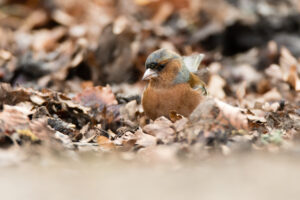About Apples
These delicious treats originated out of Central Asia and Europe having since been spread to North America by European colonists. Despite long propagation times and large plots of land generally dedicated to apples, trees can surprisingly take up less space than you think and produce before you know it. Also, even though they are cultivated around the world and are of one of the most popular fruits in society, they can be homegrown and deliver massive rewards for the self-grower. Apple trees can be grown in USDA Hardiness Zones 3-8 due to their different varieties. Thanks to their ability to grow in cooler temperatures, some breeds can extend grow time into fall and for some regions, even into the winter. Though, they must be more mild winter regions near the south.
Planting Apple Trees
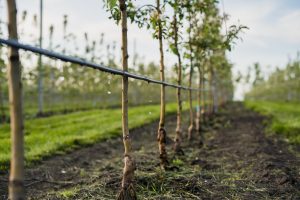
Apples grown from seed are different from those of clonal grafting and apple cultivation. They tend to lack desired characteristics that consumers want which is why most farmers spend years getting to the point of selling apples to the consumer front. Additionally, each variety requires different chill hours (amount of time tree is in 32–45-degree weather) to set the fruit and to grow properly. Keep in mind that when planting apple trees, you may want to plant a second one as well. They will need help cross-pollinating each other to reduce the chances of low yield, misshapen apples, and to reduce high pests and bug destruction.
To begin planting, make sure to choose an area of direct sunlight to allow for the desired 6-8 sun exposure hours.
Ensure that the soil is a medium to lightly compacted texture to allow for good drainage. Apple tree roots can easily fall victim to rot if overwatered and not draining.
A soil pH of 6.0 is good for the roots to grow properly and healthily.
Dig a hole two feet deep and twice the size of the root system. Then, plant the tree and compact with light soil. Lightly press on the soil to make sure that roots do not have entanglements or air pockets that could slow growth.
It is recommended to grow with a support stake because heavy yielding trees have a good chance of leaning or falling in early stages.
Growing Apple Trees
You’ll want to stick to a regular watering routine and make sure that they have enough nutrients to grow properly and that the root system starts to take on the harder soil.
By using Melnor® smart watering timers, you can conveniently stick to your watering schedule so that your apple trees grow fast and strong.
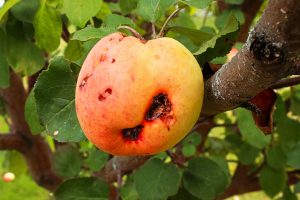
Bugs and pests love apple trees so if you use mulch, every so often, change out the old and put in new so that they can’t nestle in and chew away at the bark. Since apple trees are so susceptible to pests, it would be wise to use pesticides in protecting your fruits. Just make sure to use the pesticides at the right time making sure not to harm pollination efforts by bees.
Organic methods of pesticide are possible which include paper bags over fruits, neem oil, jojoba oil, Bacillus Thuringiensis.
Caring for Apple Trees
Once the tree has begun adequate maturation (2-4 years), take your time pruning as this leads to a slower tree growth in the younger stages.
Only remove dead, broken, or misplaced branches to achieve a directed growth.
Once the tree has filled in, you will want to prune yearly (during dormant season) to form your tree in a directed growth pattern. Leaving overcrowded, dead, or dying limbs take away from your tree’s potential. By pruning, you can give your apple tree more light exposure and increase air circulation.
Harvesting the Apples
After all that you have invested in your apple trees; time, energy, and money, it would be a waste to harvest before they are at their peak. Wait patiently and when the time is right, pluck your apples by cupping them and twisting slowly against the stem. You’ll want to wait until their color is no longer a hard green. Although, different varieties mature at different rates so make sure to check in with your cultivar’s harvest time (August-October).
What To Look For In Apples
A hardened exterior is usually the optimal time for harvesting but make sure to base this off color as well. Most varieties are multi-colored, but a good rule of thumb is to check the base color of your apples. Also, another way to check is to cut an apple in half and check the seed color. If the seed color is white, it still has some ripening to do. If the seed color is brown, your apple is ready!
Unripe: Soft, pale green, not full and not “ballooning” out past Calyx
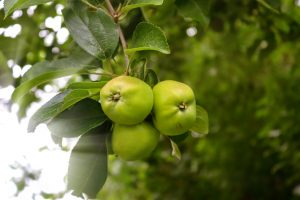
Ripe: Hardened, Full, “Ballooning” out past Calyx
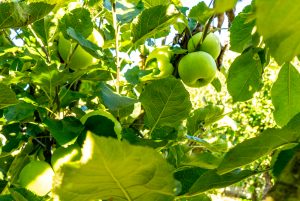
Apple Facts
- There are over 7,500 cultivars of apples
- In 2018, over 86 million tons of apples were grown
- An apple is composed of 86% water and 14% carbohydrates
- Apples and cheeses can reduce plaque buildup on your teeth
- 2 pounds of apples can only make up one 9-inch pie
- Apples are the second most valuable fruit grown in the US; Oranges are first.
- The largest apple picked was 3 pounds
Sources
“Apples and More” University of Illinois Extension, https://web.extension.illinois.edu/apples/facts.cfm. Accessed 5 August 2021.
Boeckmann, Catherine. “Growing Apples” The Old Farmer’s Almanac, https://www.almanac.com/plant/apples. Accessed 5 August 2021.
Flanigan, Amanda. “Organic pesticides & Fungicides for Fruit Trees” SFGATE, https://homeguides.sfgate.com/organic-pesticides-fungicides-fruit-trees-48019.html. Accessed 5 August 2021.
Huffstetler, Erin. “How To Tell When Apples Are Ready To Pick” My Frugal Home, 24 August 2016. https://www.myfrugalhome.com/how-to-tell-when-apples-are-ready-to-pick/. Accessed 5 August 2021.
Wikipedia contributors. “Apple.” Wikipedia, The Free Encyclopedia. Wikipedia, 3 Aug. 2021. https://en.wikipedia.org/wiki/Apple. Accessed 5 Aug. 2021.



